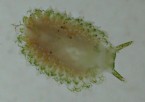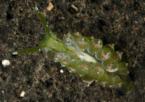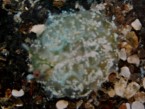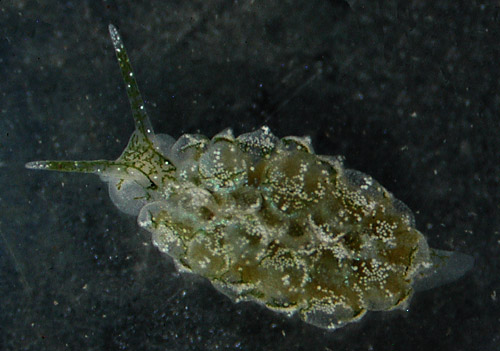_______________
Additional Photos

pericardium

cerata detail

underside

brown flecks

feeding

resting posture
_______________
GALLERY

|
Ercolania cf. coerulea Trinchese,
1892

Maximum size: 6 mm.
Identification:
This
species
has a cream body with extensive green branches of the
digestive gland and scattered white flecks. The cerata are greatly
inflated and
decorated with iridescent blue-white flecks. Occasionally, there are a
few brown flecks on their dorsal surfaces. There are carrot-shaped
branches of the digestive gland in the centers of the cerata and thin,
lateral branches in the tips of the central ones. The pericardium is
opaque white.
Natural history:
Ercolania cf. coerulea is a moderately rare
species found in moderately protected to moderately exposed rocky
habitats at depth of 1-2 m (3-5 ft). It usually occurs in
association with green algae of the genus Dictyosphaeria and we've observed
it feeding on that genus in dishes (probably on D. cavernosa). It shows a
preference for resting on its host alga while held and is superbly
camouflaged on it. When resting, it contracts slightly so its
cerata create a circular outline resembling a small lobe of the alga
and the individual cerata closely resemble the algal cells. It readily
autotomizes the central cerata when disturbed and lays a flattened
white egg mass.
Distribution:
Maui and Oahu: it is probably widely distributed in the Indo-Pacific.
Taxonomic notes:
The
pattern of digestive gland branches and pigmentation appear to
differ somewhat from the Atlantic Ercolania
coerulea and from some Pacific animals attributed to that
species. It was first recorded in Hawaii from Hekili Point, Maui by CP
on May 3, 1991.
Photo: CP:
Hekili Point, Maui; May 31, 1991.
Observations and comments:
Note
1: ( )
|
|







